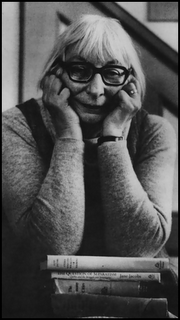
Douglas Martin, Jane Jacobs, Social Critic Who Redefined and Championed Cities, Is Dead at 89 (New York Times, April 26) Mary Rourke, Jane Jacobs, 89; Urban Theorist, Community Activist Who Fought Lower Manhattan Freeway Plan (LA Times, April 26) Hillel Italie, 'Cities' author Jane Jacobs dies at 89 (AP via Boston.com, April 26) Matthew Grace (Ed.), Jacobs' Legacy (New York Observer - The Real Estate, April 26) Inga Saffron, A visionary author saw how cities work (Philadephia Inquirer, April 26) Adam Bernstein, Jane Jacobs, 89; Writer, Activist Spoke Out Against Urban Renewal (Washington Post, April 26) |
For D.C., Jacobs’s work means the Kennedy Center is a no-no (‘concrete plaza’ remote from everything else, with constricted access by car or on foot — no wonder it’s hard to dine and enjoy the symphony etc. in a relaxed manner); the 7th Street corridor redevelopment (if a recent walk there is any indication) is pretty good, with shops, residences, the MCI Center, and art galleries all interacting to keep the street lively. Washington, with its low densities and linking of traditional neighborhoods like Georgetown, Capitol Hill, and Brookland, could easily embody the principles of Jacobs’s Death and Life of Great American Cities. That it seldom does is no doubt a function of politics, D.C.’s strict height limitations, the legacy of segregation, and an overlay of the Central Planning approach to developing and redeveloping urban blocks which is hard to escape.
Jane Jacobs, as most of her obituaries note, could never be typecast as left-vs.-right (politically) or planner-vs.-libertarian (in urban design). The New Urbanists tried to claim her but she kept her distance; same with the Smart Growth crowd. I had the pleasure of meeting Ms. Jacobs on the occasion of her receipt of the Vincent Scully Prize from the National Building Museum in 2000 and know she will be missed: but her work will not, as it’s likely to influence how we live for many, many years to come. Let’s hope she gets a look the next time a new cultural center or arts venue is proposed for the D.C. area. Baltimore, too.
No comments:
Post a Comment